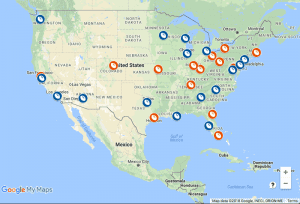General opposition to the free trade agreement in both countries is expected from workers and companies in import-competing industries, which bear the brunt of the adjustment costs of a trade agreement. Despite the gains in well-being for society as a whole (e.g. B, more efficient allocation of resources, cheaper imports and a wider choice of goods), industries facing increased competition face additional pressure to reduce costs, wages and prices. Some businesses may not be able to withstand these pressures and may be forced to close their doors, accompanied by job losses. In these circumstances, certain interest groups may, out of self-interest, oppose trade agreements that accelerate competition and structural change in an economy. In the United States, the deal would threaten manufacturing workers who produce trucks and cars, as well as rice, sugar, chicken and other farmers, as well as some sectors of the fishing industry, especially shrimp. On the Thai side, where it is estimated that about 1.6% of adults are infected with HIV or AIDS, civil society groups have already begun to address the expected damage the agreement would inflict on the continued access of AIDS/HIV patients and other medical patients to affordable medicines. The deal could also face strong opposition in Thailand as it could affect Thai sovereignty, including the possible restructuring of Thai laws that have traditionally restricted foreign ownership of property. Thai companies that profit from “pirated” U.S. products such as CDs, DVDs and software will lose under the deal while the U.S. requires Thailand to adopt strict new copyright protection.
Environmentalists fear the impact the free trade agreement could have on Thailand`s precious natural resources, which are home to several endangered species. President Bush and former Thai Prime Minister Thaskin agreed on 19 October 2003 to negotiate a bilateral free trade agreement. Six rounds of negotiations were held, the last in Thailand from 10 to 13 January 2006. U.S. trade officials had hoped to conclude negotiations in early 2006, but negotiations were suspended by Thailand in February 2006 due to the political crisis in Bangkok. After 18 months of negotiations, the two sides were very far apart on a number of issues such as the liberalisation of financial services and a number of other sensitive issues. Combined with considerable public opposition to Thailand`s free trade agreement, the Bush administration may struggle to conclude negotiations before the trade promotion power expires in mid-2007. While the Thai government, appointed by the military after the September 2006 coup in Thailand, remains committed to concluding a free trade agreement with the United States, it also plans to submit an agreement to the 242nd National Legislative Assembly (NLA) for approval – a move that ousted Prime Minister Thaskin did not deem necessary. At present, however, there are no plans (date or place) to resume negotiations. The United States and Thailand began negotiations on a comprehensive bilateral free trade agreement in June 2004. Describes the trade agreements in which this country is involved. Provides resources for U.S.
companies to obtain information on the use of these agreements. From the perspective of U.S. foreign policy interests, the Government considers that the proposed free trade agreement strengthens cooperation with Thailand in bilateral, regional and multilateral for a. Bilaterally, the free trade agreement is seen as strengthening Thailand`s position as a major military ally, especially in the war on terror. At the regional level, the free trade agreement is seen as a step forward in President Bush`s Enterprise for ASEAN (EAI) initiative. The objective of the EAI is to negotiate a network of bilateral trade agreements with the 10 ASEAN members.2 Multilaterally, Thailand plays a leading role in the World Trade Organization (WTO). A free trade agreement could encourage Thailand to actively work with the United States to support multilateral trade negotiations under the auspices of the Doha Development Agenda, particularly in the area of agricultural liberalization. Countries concluding free trade agreements agree at least to phase out tariff and non-tariff barriers (BARRIERS) to mutual trade in goods in order to improve market access between trading partners. Most U.S. free trade agreements, including NAFTA and the agreements with Chile and Singapore, are more comprehensive.
Since the U.S.-Thailand Free Trade Agreement is modeled after the Singapore Free Trade Agreement, no sector, product, or functional problem can expect to be excluded from the liberalization process. This approach is favored by many members of Congress. As a result, the negotiations cover trade in goods and services, agriculture, investment and intellectual property rights, as well as other issues such as government procurement, competition policy and customs procedures. The total value of bilateral agricultural trade in 2002 was about $1.2 billion, with the United States running a deficit of $377 million. Thailand`s top exports to the United States are processed seafood, frozen shrimp, rubber, rice, tapioca, sugar, and fruits and vegetables. Thailand`s top imports from the U.S. include oilseeds, cotton, grains (especially wheat), soybean oil, and oilcake.9 Companies defending the trade and investment deal include Unocal, General Motors, and Nike. Resistance in the U.S. could come from groups concerned about the impact of the trade deal on labor and environmental standards. These interest groups, often joined by anti-globalization activists, question whether trade agreements improve the social well-being of participating countries. .


